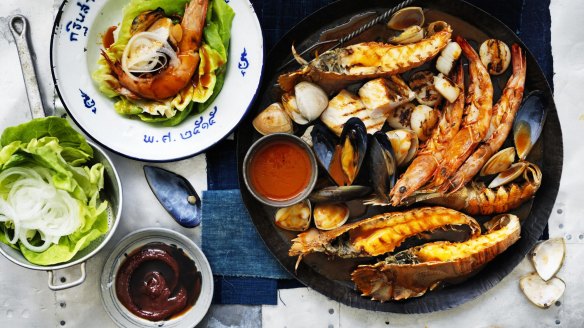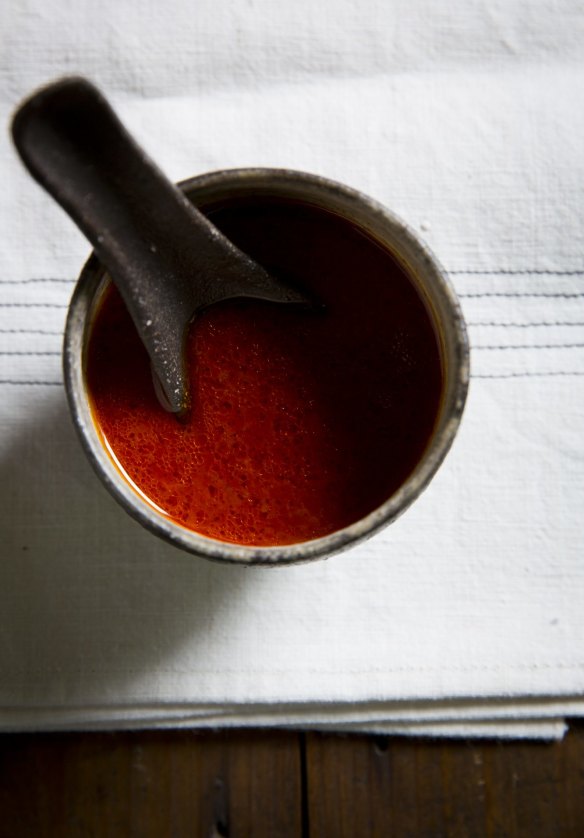Guide to gochujang: How to use the spicy Korean chilli paste
Updated , first published

- Neil Perry's seafood with gochujang butter (pictured above)
- Try it in these 21 Korean-inspired recipes
If you've ever been to a Korean restaurant, you've undoubtedly encountered gochujang. It adds the heat to bibimbap, lends the rich red colour you see in tteokbokki (stir-fried rice cakes) and forms the backbone of ssamjang, the sauce most often served with Korean barbecue.
It also looks ferocious. Even the packaging does. Almost every container of the Korean paste is bright red, with pictures of chillies plastered all over the label in case you didn't get the hint. Pop open the container, peel back the plastic covering and you'll uncover a dark red paste as thick as tar.

This can make gochujang seem more like a dare than an integral component of the Korean kitchen, but it is far more versatile and complex than it might first appear.
What does it taste like?
Sure, gochujang has heat – depending on the brand, it can be extraordinarily spicy – but it also has a salty, almost meaty depth and a slight sweetness. In other words, it's not a one-note hot sauce that you add to a dish after the fact. If you want to see Korean chefs bristle, tout gochujang as the "next Sriracha".
One of those chefs is Bill Kim, author of the cookbook Korean BBQ. "Why can't it be its own thing?" says Kim. "Here is something that people having been eating and using for centuries. It has its own distinct flavour. It's from Korea, not from Thailand or China."
He believes gochujang works best when mixed with other ingredients. "It's too intense by itself for most people, even for Korean people," says Kim. "At (my restaurant), we always cut it with water, vinegar and sugar. You don't take gochujang and put it on a pork chop. You need to dilute it." He likens it to a "spicy miso paste", which can immediately add a depth to a dish.
What's it made of?
Gochujang starts with meju, a brick of dried and fermented soybeans that traditionally takes many months to create. When his family lived in Korea, Kim's parents made it from scratch. The process starts with soybeans that are boiled and then formed together into blocks and dried.
But even if you happen to have some meju hanging around, gochujang still requires effort. To finish, the meju is mixed with gochugaru (Korean red pepper powder), rice flour, salt and maybe a sweetener. This mixture then needs to ferment for months. Considering how long it takes, don't feel bad about buying your own. Speaking of which ...
How to buy it
It's easy to spot gochujang in a Korean grocery store – just look for those bright red containers. But if you're not fluent in Korean, figuring out exactly which one to get can feel intimidating. Fortunately, while most of the text on the container might be Korean, often there will be a sticker that lists the ingredients in English. Cheaper versions will have corn syrup and unpronounceable (even in English) ingredients in the mix. Kim recommends the brand Chung Jung One.
How to use it
As mentioned above, gochujang is crucial to such Korean classics as bibimbap, tteokbokki and ssamjang. But that's just the beginning.
Kim also uses it a lot in stews and meat dishes to add an instant depth and complexity.
Chef Neil Perry says: "Gochujang will keep in the fridge and is great added to stir-fries. I also like to combine it with soy, sugar, vinegar and sesame oil to make a wonderful dressing for seafood. Once you have it in your kitchen, you'll be as addicted as I am."
Chicago Tribune
The best recipes from Australia's leading chefs straight to your inbox.
Sign upMore:
From our partners
Original URL: https://www.theage.com.au/link/follow-20170101-h1d2dh